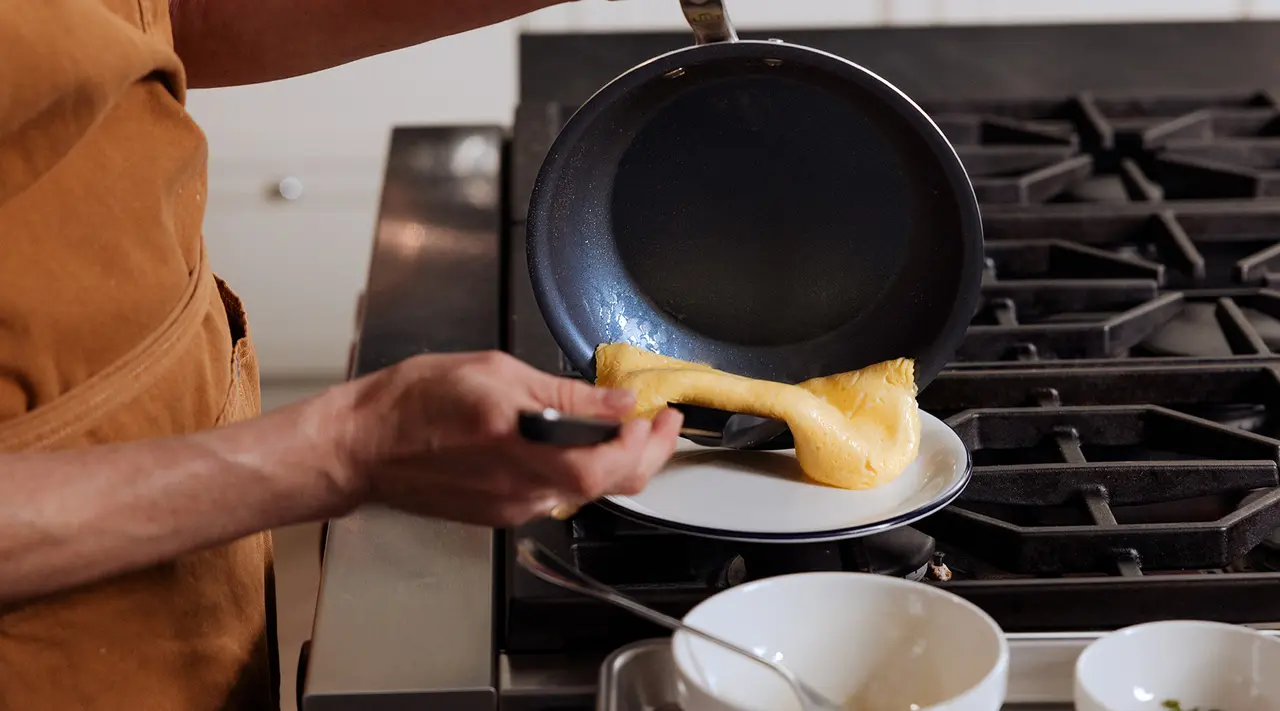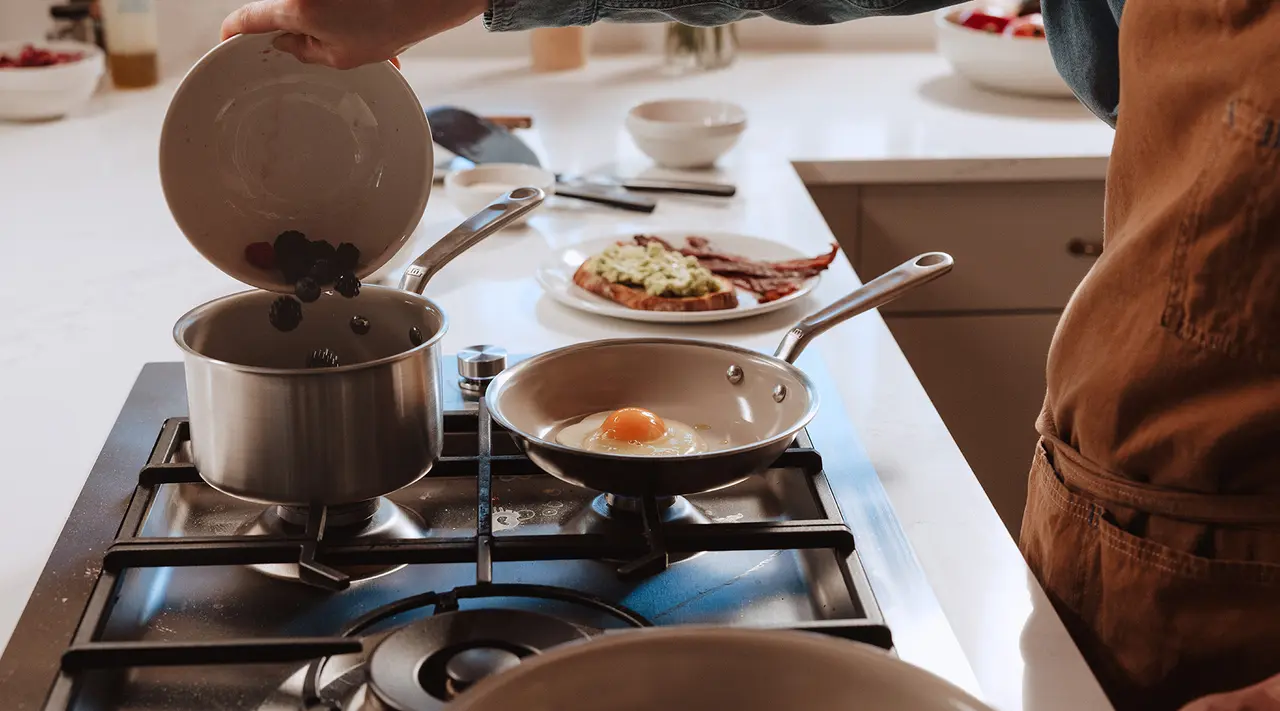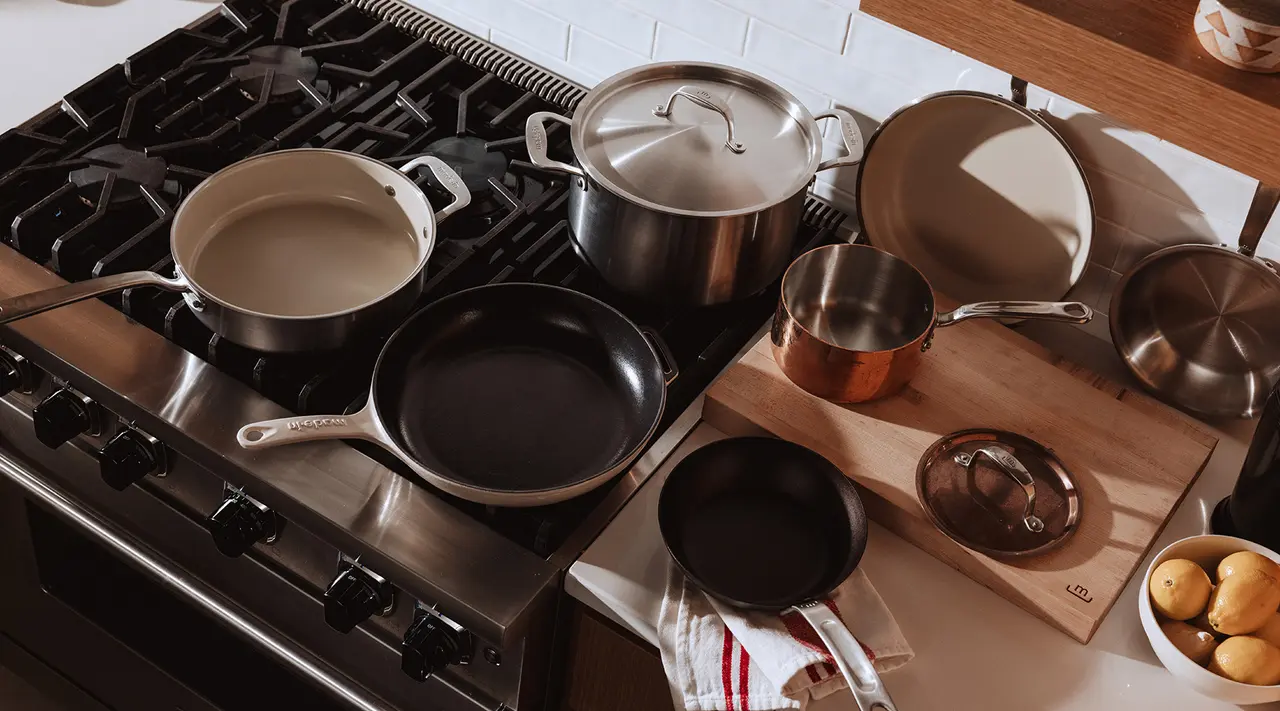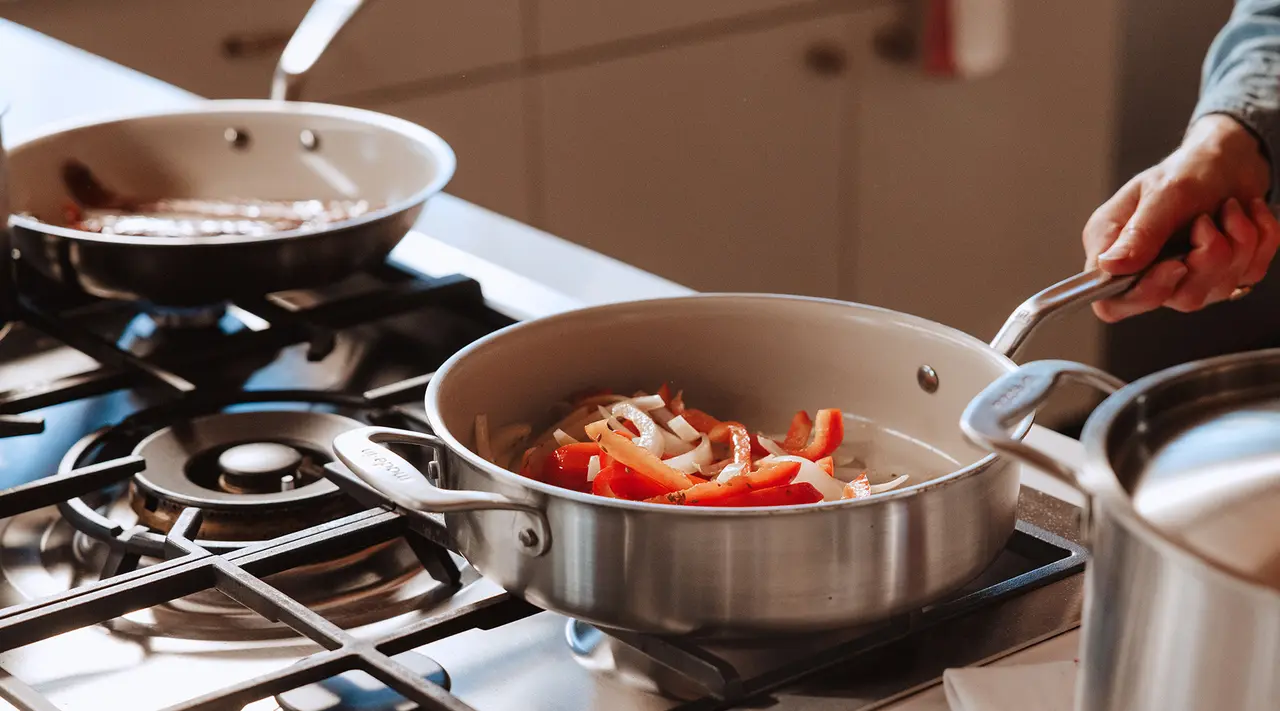In the past few years, the "non stick" cookware landscape has grown dramatically. Instead of the standard, coated non stick frying pans you may be used to, there are now entire categories of non stick cookware of varying coating materials.
The two biggest competitors in this space are conventional, coated non stick and ceramic non stick cookware. The latter is a more recent addition to this space, but you've probably seen the ads for pans in a wide array of colors that promise to do everything traditional non stick can—save for the chemicals.
To simplify things, we’ll explain the ongoing debate between ceramic vs non stick cookware and how to pick one or the other for your own kitchen.
What Is Ceramic Cookware?

Rather than glazed, kiln-fired clay (like stoneware or porcelain bakeware), the coating of ceramic cookware is actually derived from a naturally-occurring substrate, with the name ceramic coming from its glossy surface. This coating boasts the same no-stick properties as conventional non stick.
Ceramic functions almost identical to non stick cookware, where the coating is applied over top of a base of a conductive material, often aluminum or stainless steel (and sometimes both—like our 5-Ply Stainless Clad, which makes up the base of our CeramiClad™ Collection). This is what gives ceramic cookware the ability to conduct and circulate heat like the non stick you’re used to.
Advantages of Ceramic Cookware
Conventional non stick and non stick share many similarities—but the main advantage of ceramic cookware over non stick is simple. While all of the modern non stick cookware is completely safe and free from harmful chemicals and heavy metals like lead and cadmium, ceramic cookware is (and always has been) free from those same concerns. Conventional non stick cannot say the same, hence many people opting for ceramic, knowing it can provide an added layer of assurance.
Don't interpret this as a dig on traditional non stick or a question of its safety—modern coated non stick is safe to use, eat from, and made without harmful chemicals.
Considerations of Ceramic Cookware
Ceramic cookware isn’t without its considerations. First, there’s the price: ceramic pots and pans tend to come with a higher price tag—especially when you’re buying from trendy brands commonly seen on Instagram. And while you can definitely find a decent ceramic frying pan at an affordable price, there aren’t quite as many budget-friendly options as there are with non stick due to how recent the technology is.
The other drawback to ceramic is the same critique that can be applied to all non stick cookware: it’s not going to stay non stick forever. This is because of that coating mentioned previously—the naturally-derived non stick coating tends to degrade faster than traditional non stick cookware. The good news is, if you opted for a high-quality ceramic pan (like our CeramiClad™ line), it's still the same high-quality pan once the coating has faded—it'll just need a little help from oil or butter to be non stick once more.
What Is Non Stick Cookware?

Traditional non stick cookware is made using a metal base—usually stainless steel and/or aluminum—coated with layers of non stick coating. This allows non stick pots and pans to have an unmatched ability to repel water and oil and prevent eggs, fish, and other delicate foods from sticking.
Advantages of Non Stick Cookware
The non stick surface makes non stick pots and pans much easier to clean and maintain, even without putting them in the dishwasher (which you probably shouldn’t be doing anyway).
Non stick is also one of the cheapest cookware options you can buy, and they’re available at a range of different price points: You can spend as little as $10 on a decent non stick pan (though we still think it’s worth investing more for a higher-quality pan that will last longer).
Considerations of Non Stick Cookware
While we definitely endorse non stick cookware as a convenient, lightweight, and relatively inexpensive option, we understand that it’s not the best choice for everybody. While non stick tends to outlast most ceramic cookware, it’s still not built for long-term use: at most, you’ll get a few years out of your pan before the coating starts to wear down.
One of the other hesitations many have about non stick cookware is its complicated history with chemicals. In the past, certain (not all) non stick cookware was manufactured using a chemical called PFOA, or perfluorooctanoic acid. This is part of a family of compounds called PFAS, or per- and polyfluoroalkyl substances, some of which are associated with an elevated risk of health issues.
PFOA was phased out from cookware manufacturing in the U.S. since 2003 and banned permanently in 2014, but it’s important to do your research to ensure your safety—particularly if you’re using a non stick pan made prior to 2014. Rest assured that all non stick cookware manufactured in the USA and Europe, like our ProCoat line, are made without these harmful chemicals.
How Do Ceramic and Traditional Non Stick Compare?

Here’s how ceramic and non stick cookware stack up in terms of performance, durability, and ease of care.
Cooking Performance
Ceramic and non stick cookware perform roughly the same way—both offer a smooth, stick-resistant surface that’s ideal for cooks trying to cut down on cooking fats like oil and butter. A high-quality ceramic or non stick pan will generally do a better job with qualities like heat distribution than a flimsy, poorly-constructed one (especially one made using Award-Winning Stainless Clad construction, like ours).
Since neither type of pan is recommended for consistent use over high heat, they’re also not recommended for high-heat cooking methods like deep frying. Both options are typically induction compatible.
Durability
While neither ceramic cookware nor non-stick cookware is built to last as long as, say, a stainless steel or enameled cast iron pan, non stick has an edge on ceramic in terms of durability. The coating on a properly cared-for non stick pan can last considerably longer than a ceramic pan, but both can still be used after the coating has worn out (just without their trademark non-stickiness).
Ceramic’s main advantage over non stick is that while not all non stick cookware is PFOA-free (like if it was made prior to 2014, or recently in a country without an active ban on PFOA), all ceramic cookware is made without PFAS.
Maintenance and Care
While constructed differently, ceramic and non stick pans should both be treated roughly the same way—that is to say, delicately. They should both be hand washed using a gentle dish soap and soft sponge to keep from damaging the coating, and you should similarly avoid using metal utensils when cooking with them. You should also avoid cooking sprays when cooking with either option, as these can build up on the surface of your pan and become impossible to remove without damaging the coating.
It’s generally recommended to cook over low or medium-low heat when using ceramic or non stick—higher is fine on an infrequent basis, but keeping it low is best to preserve the coating (and there are other pans better-suited to high heat cooking, anyway).
Be sure to always heat them with oil or an ingredient in the pan, and while they’re often oven-safe, it’s best to avoid putting them in a very hot oven (think higher than 500F) for extended periods of time.
Which Cookware Option is Right for You?

Like with any new piece of cookware, the best choice for your specific needs is completely up to you. Both options have upsides and drawbacks, and it all depends on your budget, cooking habits, and safety preferences.
Ceramic cookware provides a cooking experience on par with that of non stick, though with a relatively limited lifespan; on the other hand, non stick is more durable, with a coating that won’t break down as quickly.
Ready to Shop?
We never want you to stress out about your cookware. And since nothing should come between you and your late-night breakfast tostadas, we endorse whatever pan—ceramic, non stick, or otherwise—you decide to add to your collection. And with our Non Stick Collection, featuring both CeramiClad™ and ProCoat Non Stick, you can't go wrong with either option.





















